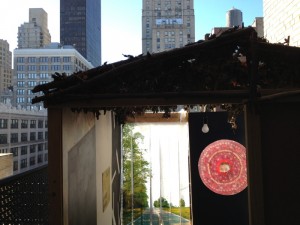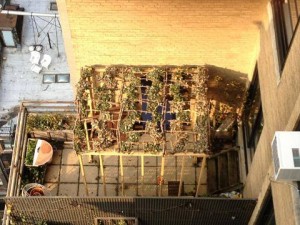Art. Collaboration. Openness. Ritual. A “Sukkah Salon”

Sukkah Salon
“Sukkah Salon” is a collaborative artwork by artists Megan Berk, Brent Birnbaum, Danielle Durchslag, Shannon Finnegan, Ryan Frank, Sarah Hardesty, Jessie Henson, Claudia Paneca, Shana Siegel, and Ian Trask.*
On a terrace in Manhattan, the dried leaves on one panel of a collaborative sukkah by 10 visual artists of different religious backgrounds capture the light of the seasonal sun. In many ways, a sukkah is a reflection of the individuals or community that creates it. This one is, too. In this case, though, the sukkah is part artistic creative process and part point of departure for a site-centric series of salons and an open house this Sunday. Its creators hope to create an avenue for interpersonal inspiration and engagement: spiritually, socially, creatively, psychologically.
“Assembly Required: Sukkah Salon” — brainchild of Danielle Durchslag, created with co-curator Ryan Frank — bridges identities to explore a Jewish ritual and the Feast of Booths in an intimate space shaped by Jewish restrictions on everything from materials to size, yet embracing the room between these restrictions that creates openness.
The two curators share a commitment to creative collaboration but completely different religious backgrounds. Danielle Durchslag is a Jewish Buddhist who says her Upper West Side synagogue, Romenu, fits her to a T in its integration of “Eastern spiritual practices with traditional Orthodox influences … to foster greater levels of compassion.” Meanwhile, Ryan Frank, is a self-described agnostic who was raised Catholic. “The topic of religion fascinates me, and this project is the first time I’ve explored this interest creatively.”
For these two, Ryan says, this project took form when we started exploring “similarities between the rituals of religion and that of art exhibitions and openings.”
And yes, it’s for everyone who’s curious, not just Jews.
Outside Art, Internal Inspiration? A Q & A with Artist-Co-curator Danielle Durchslag
Erica Brody: You conceived of “Assembly Required: Sukkah Salon” as a way to bridge your two main social communities, one artistic, the other religious/spiritual. How has your relationship to the rituals of art and religion been impacted?
Danielle Durchslag: I love ritual. I love art openings, and Buddhist sangha gatherings, and artist critique evenings, and Yom Kippur services. Ritual of one kind or another runs through the two most important parts of daily my life: art and spiritual practice. However, I’ve noticed over the years that my two communities — those I pray with and those I engage around art with — rarely share space. I have had some religious friends come to art openings and I have, rarely, welcomed my art world friends into spiritual space, but only fleetingly. In my art practice I’ve been frustrated by my discomfort with bringing my spiritual practice and identity into the objects I make. Somehow the two have stayed separate. This exhibition is an attempt to bridge those worlds.
In terms of my work, this show has given me permission to create a much more spiritual piece than I would under normal circumstances. My panel is about being between a Jew and a Buddhist, being between my former self and the more compassionate self I desire to become. It includes the kind of plastic grapes I used as a little girl to decorate our sukkah, as well as a portrait of Garchen Rinpoche, a great Tibetan Buddhist monk and teacher. I’ve never made a piece of art before that so honestly and directly portrays my spiritual path – “Assembly Required” has freed me in that way.
I’ve always wanted to build a sukkah on my balcony, but never got around to it. This year I resolved to make it happen, which led me to focus more on the holiday than usual. As I thought back to the sukkah-building of childhood, I remembered two main activities: decorating the structure and welcoming guests inside. It occurred to me that those two items could also describe an art exhibition: you visually alter the space and then ask people to come experience it. The idea for a fine art sukkah experience started there.
EB: For “Sukkah Salon,” you’ve brought 10 artists of different stripes into a collaborative art project: to create a sukkah. Yet you’re also creating a salon experience inside the sukkah. What do you hope will happen during these salons? Obviously you mean them to be more than an “art opening,” per se.
DD: The salons are an open space for dialogue, discussion, and engagement of all kinds, inspired by the holiday of Sukkot and “Assembly Required.” We’re providing an unusual physical environment for conversation — an intimate, outdoor fine-art space that is also employed for religious ritual. When Ryan and I first envisioned the project we imagined this kind of space as one that would generate/give permission for discourse on culture and the Divine. The salons are an opportunity for participants to dig in and share their thoughts about the show, the holiday, the physical structure, and anything else that the physical experience inspires.
EB: Sukkot is such a great gateway for bringing creativity and community at the same time, providing a space – literally — for innovation and tradition. Have you found new ways to think about Judaism as you’ve collaborated with artists of different religious backgrounds?
DD: We have artists in this show who never heard of a sukkah before this project, artists who have been in one but didn’t know what it was about, and artists like myself, who grew up observing the holiday. The full range. All of them, regardless of background, have experienced the sukkah as an appropriate site for creating meaning. I suppose I’ve learned that the sukkah can inspire people who hold no nostalgic or personal connection to the structure. The ideas/themes made manifest by the structure are enough.
EB: In celebrating vulnerability and temporariness, many before you have found an opportunity during Sukkot to raise awareness or start conversations about social justice issues: freedom, slavery, environmental justice, homelessness, for example. Will “Sukkah Salon” be a space for exploring similar themes?
DD: We asked every artist to approach the sukkah as the in between made manifest, and to make work about the unresolved/longed for in their lives. Every panel approaches the theme differently- some engage issues of social justice and others do not. We have work about the Israeli/Palestinian conflict and our failing food systems, and work that is deeply personal and psychological. We wanted every artist to engage the unresolved in the area most meaningful/pressing for them, and I’m thrilled there’s such a range of topics covered in the structure. It goes back to the salon idea — the sukkah as a place capable of holding and encouraging every kind of conversation.
EB: Back in 2010, New York saw the most ambitious international sukkah art project ever, with Sukkah City, brainchild of writer Joshua Foer and Rebooter Roger Bennet. That project ended up with 600 submissions from 43 countries, and 12 finalists whose work — installed in NY’s Union Square — put sukkahs in the headlines, and even spawned its own documentary by the aptly named Jason Hutt, screening Sunday in Union Square. That obviously was intended to spark dialogues far beyond the people involved. Does that project have any bearing on yours, which seems far more personal, aimed at the participating artists and the very personal individual experiences of everyone who spends time together within its temporary walls?
DD: I loved Sukkah City! I saw it at least twice and found it totally inspiring. While it wasn’t a conscious part of our thought process with this show, I’m sure Sukkah City planted a seed somewhere in my brain about the creative, visual opportunities presented by the sukkah. For artists, restrictions are often exciting and generative, parameters to be worked with/around to produce compelling solutions. The sukkah structure is defined through restrictions, making it a ripe place for creative endeavor. Sukkah City probably helped me to view sukkahs that way.
However, unlike that show, our concerns are not primarily architectural. We were less engaged with the basic physical structure and much more interested in the visual/emotional experience inside the sukkah. Sukkah City was a wonderful gift to New York, but it wasn’t crafted for the kind of intimate, interpersonal connecting we’re hoping to foster. They’re very different projects, but I’m certain ours owes something to that great show.
EB: What three words would you use to describe the sukkah that the collaborating artists have built?
Interdependent, striking, playful.
EB: You’re inviting anyone who’s curious – regardless of religious or artistic affiliation – in the art sukkah this Sunday. What should people bring?
DD: On Sunday people should bring an openness to an unusual environment and to each other.
EB: What else?
DD: The last thing I’d like to add is what a reminder this show has been to me about the generosity of artists. Artists gave of their time and talents to an amazing degree for this experience, beyond my most positive hopes, and the results are really exciting. They have created wonderful work, and we’re grateful.
“Sukkah Salon”: With artwork by Megan Berk, Brent Birnbaum, Danielle Durchslag, Shannon Finnegan, Ryan Frank, Sarah Hardesty, Jessie Henson, Claudia Paneca, Shana Siegel, and Ian Trask.
Celebrate Sukkot! The opening reception for “Sukkah Salon” is Sunday, September 22nd, from noon til 8 pm at 88 Lexington Avenue #14K. Sukkah Salon runs through September 25th. Want to visit? Email sukkahsalon@gmail.com. Note: the artist-creators followed Jewish law as closely as possible but ended up using twine for safety reasons.
![[the current issue of ZEEK]](../../image/2/100/0/5/uploads/leftistethicistgraphic-52842c6a.png)
- 5000 Pages of Zeek
- Founded in 2001, Zeek was the first Jewish online magazine, and we have over 5000 pages online to prove it, all available free of charge. Read more in the Archive.
More articles by
Erica Brody
- Talking About Race, Identity & Making Noise with Amani Hayes-Messinger
- When Is an Acceptance Speech Really a Speech About Acceptance?
- Ten Things You Should Know About ZEEK & Why We Need You Now
- A ZEEK Hanukkah Roundup: Act, Fry, Give, Sing, Laugh, Reflect, Plan Your Power, Read
- #ThisStopsToday: A Response to the Eric Garner Decision
More articles in
Arts and Culture
- Euphoria, Curiosity, Exile & the Ongoing Journey of a Hasidic Rebel: A Q & A with Shulem Deen
- Poet Q, Poet A: Jews Are Funny! Six Poets on Jewish Humor, Poetry & Activism and Survival
- Tackling Hate Speech With Textiles: Robin Atlas in New York for Tu B’Shvat
- Fiction: Angels Out of America
- When Is an Acceptance Speech Really a Speech About Acceptance?



